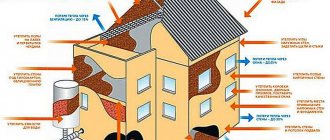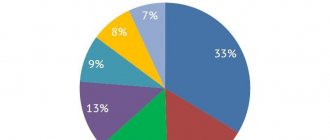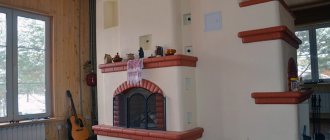Most often we think about how much fuel we have used when bills for the heat received arrive. And if the amount is frighteningly large, we begin to carry out calculations. There are methods that make it possible to calculate, for example, both at the design stage and in a completed building, the gas consumption for heating a 200 m2 house. The results obtained will help to audit the heating system and develop methods to reduce the costs of maintaining a comfortable microclimate in the house.
Having managed to calculate gas costs, heating bills will be more pleasing Source tengrinews.kz
Gas... and other gas
Blue fuel has been the most popular and cheapest energy source for many years. Most often, two types of gas are used for heating and, accordingly, two connection methods:
- Magistralny . This is methane purified from impurities with the addition of a tiny amount of fragrance to facilitate leak detection. Such gas is transported through gas transportation systems to consumers.
- A liquefied mixture of propane and butane, which is pumped into a gas holder and provides autonomous heating. When this liquid transforms into a gaseous state, the pressure in the tank increases. Under high pressure, the gas mixture rises through pipes to the point of consumption.
Both types have their pros and cons:
- When connecting to a main line, there is always a danger of pipeline breakage and a decrease in pressure in it. The gas tank provides complete autonomy; you only need to monitor the availability of gas;
- gas tank equipment and its maintenance are expensive . But this is the only possibility of gas heating if there is no mains in the accessible vicinity;
- To calculate the gas consumption for heating a house of 100 sq. m, a comparison is made of the calorie content of the fuel from the main line and the liquefied mixture in the cylinder. The calorie content of a propane-butane mixture is three times greater than that of methane: the combustion of 1 m3 of the mixture produces 28 kW, and the combustion of the same amount of methane produces 9 kW. Accordingly, different amounts will be spent on heating the same area.
The liquefied mixture is often pumped into small containers for autonomous heating.
For autonomous heating, liquefied gas in cylinders is also used Source blog.mybacharach.com
See also: Catalog of companies that specialize in home insulation services.
General principles for calculating heating power and energy consumption
Why are such calculations carried out at all?
The use of gas as an energy carrier for the operation of the heating system is advantageous from all sides. First of all, they are attracted by the quite affordable tariffs for “blue fuel” - they cannot be compared with the seemingly more convenient and safe electric one. In terms of cost, only available types of solid fuel can compete, for example, if there are no special problems with the procurement or purchase of firewood. But in terms of operating costs - the need for regular delivery, organizing proper storage and constant monitoring of boiler loading, solid fuel heating equipment is completely inferior to gas heating equipment connected to the network supply.
In a word, if it is possible to choose this particular method of heating your home, then there is hardly any doubt about the advisability of installing a gas boiler.
In terms of efficiency and ease of use, gas heating equipment currently has no real rivals.
It is clear that when choosing a boiler, one of the key criteria is always its thermal power, that is, the ability to generate a certain amount of thermal energy. To put it simply, the purchased equipment, according to its technical parameters, must ensure the maintenance of comfortable living conditions in any, even the most unfavorable conditions. This indicator is most often indicated in kilowatts, and, of course, is reflected in the cost of the boiler, its dimensions, and gas consumption. This means that the task when choosing is to purchase a model that fully meets the needs, but, at the same time, does not have unreasonably inflated characteristics - this is both disadvantageous for the owners and not very useful for the equipment itself.
When choosing any heating equipment, it is very important to find the “golden mean” - so that there is enough power, but at the same time - without completely unjustified overestimation
It is important to understand one more point correctly. This is that the specified nameplate power of a gas boiler always shows its maximum energy potential. With the right approach, it should, of course, slightly exceed the calculated data for the required heat input for a particular house. In this way, the same operational reserve is laid down, which may someday be needed under the most unfavorable conditions, for example, during extreme cold, unusual for the area of residence. For example, if calculations show that for a country house the need for thermal energy is, say, 9.2 kW, then it would be wiser to opt for a model with a thermal power of 11.6 kW.
Will this capacity be fully utilized? – it’s quite possible that not. But its supply does not look excessive.
Why is all this explained in such detail? But only so that the reader becomes clear on one important point. It would be completely wrong to calculate the gas consumption of a specific heating system based solely on the equipment’s nameplate characteristics. Yes, as a rule, the technical documentation accompanying the heating unit indicates the energy consumption per unit of time (m³/hour), but this is again a largely theoretical value. And if you try to get the desired consumption forecast by simply multiplying this passport parameter by the number of hours (and then days, weeks, months) of operation, then you can come to such indicators that it will become scary!..
It is not advisable to use certified gas consumption values as a basis for calculations, since they will not show the real picture.
Often, passports indicate a consumption range - the boundaries of minimum and maximum consumption are indicated. But this probably will not be of great help in calculating real needs.
But it is still very useful to know gas consumption as close to reality as possible. This will help, firstly, in planning the family budget. Well, secondly, the possession of such information should, willingly or unwillingly, stimulate zealous owners to search for reserves of energy savings - perhaps it is worth taking certain steps to reduce consumption to the possible minimum.
What increases gas consumption
Gas consumption for heating, in addition to its type, depends on the following factors :
- Climatic features of the area. The calculation is carried out for the lowest temperature indicators characteristic of these geographical coordinates;
- The area of the entire building, its number of floors, the height of the rooms;
- Type and presence of insulation of the roof, walls, floor;
- Type of building (brick, wood, stone, etc.);
- The type of profile on the windows, the presence of double-glazed windows;
- Organization of ventilation ;
- Power in the limit values of heating equipment.
The year the house was built and the location of the heating radiators are also important.
How to reduce fuel consumption for the owner of a private house
The amounts mentioned above can stun an impressionable tenant or an ordinary citizen. Well, what can you do - “your own home” was an expensive pleasure at all times. However, unlike a city dweller living in an apartment, the owner of a private home can change heating costs in his favor.
Insulating your home will help reduce heating costs
To do this, he will need to do the following:
- Insulate the facade, foundation, roof, attic and basement floors - even a thin layer of thermal insulation material can make up at least a couple thousand, or even a whole ten, from the gas bill.
- Replacing old windows with modern double-glazed windows, installing a heat-resistant panel in the doorway is another 5-10 thousand minus. Moreover, doors and windows should be tackled first, since they generate at least 40 percent of heat losses.
- Install a heat accumulator in the basement or boiler room, change the wiring diagram to a double-circuit or manifold version, which provides the possibility of point thermoregulation of radiators, purchase a boiler with high efficiency. Now there are excellent 95% devices on sale. In this case, savings can be up to 10-15 percent of the total bill.
In short, it is necessary, firstly, to increase the heat resistance of the house, and secondly, to use more energy-efficient equipment. And no one is forcing you to make these changes in one season. You can start with windows, then improve the boiler and get to the walls and ceilings. As a result, you can save up to a quarter of the stated costs.
Calculation of main gas flow
The calculation of the required power is carried out on the assumption that the height of the rooms does not exceed 3 m, its area is 150 m2, the condition of the building is satisfactory, and there is insulation. Then, to heat 10 m2 of area, an average of 1 kW of energy is consumed at a temperature lower than –10 0C. Since this temperature on average lasts only half of the heating season, you can take the base value as 50 W*m/hour.
Depending on the thickness of the wall insulation, gas consumption is significantly reduced Source m-strana.ru
Gas consumption for heating a house of 150 m2 will be determined by the ratio
A = Q / q * ɳ
- Q in the selected example is calculated as 150 * 50 = 7.5 kW and is the required power needed to heat a given room.
- q is responsible for the type of gas and exerts specific heat. For example, q = 9.45 kW (G 20 gas).
- ɳ shows the efficiency of the boiler, expressed in relation to unity. If efficiency = 95%, then ɳ = 0.95.
Let's carry out the calculations and find that the gas consumption for a house with an area of 150 m2 will be equal to 0.836 m3 per hour, for a house measuring 100 m2 - 0.57 m3 per hour. To obtain the average daily quantity, the result obtained is multiplied by 24, for the monthly average - multiplied by another 30.
If you change the boiler efficiency to 85%, 0.93 m3 will be consumed per hour.
Determining the required thermal power for efficient heating of a house or apartment
So, the starting point for determining gas consumption for heating needs should still be the thermal power that is required for these purposes. Let's start our calculations with it.
If you look through the mass of publications on this topic posted on the Internet, you will most often find recommendations to calculate the required power based on the area of the heated premises. Moreover, for this a constant is given: 100 watts per 1 square meter of area (or 1 kW per 10 m²).
Comfortable? - undoubtedly! Without any calculations, without even using a piece of paper and a pencil, you perform simple arithmetic operations in your head, for example, for a house with an area of 100 “squares” you need at least a 10-watt boiler.
Well, what about the accuracy of such calculations? Alas, in this matter everything is not so good...
Taking the axiom that 100 W of heat is required for every meter of area as a basis for calculating heating power is not a completely serious approach.
Judge for yourself.
For example, will the thermal energy requirements of premises of the same area, say, in the Krasnodar Territory or regions of the Server Urals be equivalent? Is there a difference between a room bordering on heated premises, that is, having only one external wall, and a corner one, and also facing the windward north side? Will a differentiated approach be required for rooms with one window or those with panoramic glazing? You can list a few more similar, quite obvious, by the way, points - in principle, we will deal with this practically when we move on to the calculations.
So, there is no doubt that the required amount of thermal energy for heating a room is influenced not only by its area - it is necessary to take into account a number of factors related to the characteristics of the region and the specific location of the building, and the specifics of a particular room. It is clear that rooms within even the same house can have significant differences. Thus, the most correct approach would be to calculate the need for thermal power for each room where heating devices will be installed, and then, summing them up, find the total figure for the house (apartment).
Each room may have individual characteristics, so it is advisable to carry out calculations for the rooms separately, and at the end - to summarize the total
The proposed calculation algorithm does not claim to be a professional calculation, but has a sufficient degree of accuracy, proven by practice. To make the task extremely simple for our readers, we suggest using the online calculator below, the program of which has already included all the necessary dependencies and correction factors. For greater clarity, brief instructions on how to perform the calculations will be provided in the text block below the calculator.
Calculator for calculating the required thermal power for heating (for a specific room)
Go to calculations
Explanations for thermal power calculations
So, we will count for each room separately in approximately this sequence
- We start with the area of the room. And we will still take the same 100 W per square meter as the initial value, but many correction factors will be introduced as the calculation progresses. In the input field (using the slider) you must indicate the area of the room, in square meters.
- Of course, the required amount of energy is influenced by the volume of the room - for standard ceilings of 2.7 m and for high ceilings of 3.5 ÷ 4 m, the final values will differ. Therefore, the calculation program will introduce a correction for the height of the ceiling - you must select it from the proposed drop-down list.
- The number of walls in the room that are in direct contact with the street is of great importance. Therefore, the next point is to indicate the number of external walls: options are offered from “0” to “3” - each value will have its own correction factor.
- Even on a very frosty, but clear day, the sun can affect the microclimate in the room - the amount of heat loss is reduced, direct rays penetrating the windows sensitively heat the room. But this is typical only for walls facing south. As the next data entry point, indicate the approximate location of the external wall of the room - and the program will make the necessary adjustments.
“Frost and Sun – a wonderful day...” - it really is! The sun's rays, even in winter, are quite capable of influencing the microclimate in a room facing south
- Many houses, both country and urban, are located in such a way that the outer wall of the room is windward most of the winter. If the owners know the direction of the prevailing winter wind rose, then this circumstance can be taken into account in the calculations. It is clear that the windward wall will always cool more strongly - and the calculation program calculates the corresponding correction factor. If there is no such information, then you can skip this point - but in this case, the calculation will be carried out for the most unfavorable location.
If the prevailing direction of winter winds is known, then this circumstance can be taken into account in the calculations
- The next parameter will adjust for the climatic specifics of your region of residence. We are talking about temperature indicators that are typical in a given area for the coldest ten days of winter. It is important that we are talking specifically about those values that are the norm, that is, they are not included in the category of those abnormal frosts that every few years, no, no, and even “visit” any region, and then, due to their atypicality, remain for a long time in memory.
It is necessary to indicate those indicators of minimum winter temperatures that are the norm for a given region
- The level of heat loss is directly related to the degree of thermal insulation of the walls. In the next data entry field, you must evaluate it by choosing one of three options. At the same time, a wall can be considered fully insulated only if thermal insulation work has been carried out in full, based on the results of thermal engineering calculations.
Prices for PIR boards
PIR boards
The optimal solution for a residential building is complete thermal insulation, made on the basis of thermal engineering calculations.
The average degree of insulation includes walls made of “warm” materials, for example, natural wood (logs, beams), gas silicate blocks 300-400 mm thick, hollow bricks - masonry of one and a half or two bricks.
The list also shows walls that are not insulated at all, but, in fact, in a residential building this should not happen at all by definition - no heating system can effectively maintain a comfortable microclimate, and energy costs will be “astronomical”.
- A considerable amount of heat loss always occurs in the ceilings - floors and ceilings of rooms. Therefore, it would be quite reasonable to evaluate the “neighborhood” of the room being calculated, so to speak, vertically, that is, above and below. The next two fields of our calculator are devoted precisely to this - depending on the specified option, the calculation program will introduce the necessary corrections.
The total amount of heat loss in a room is influenced by what is located above and below it
- An entire group of data entry fields is dedicated to windows.
— Firstly, you should evaluate the quality of the windows, since this always determines how quickly the room will cool down.
— Then you need to indicate the number of windows and their sizes. Based on this data, the program will calculate the “glazing coefficient”, that is, the ratio of the area of the windows to the area of the room. The resulting value will become the basis for making appropriate adjustments to the final result.
It’s probably clear to anyone that the amount of heat loss through windows that differ so much in size will be far from the same
- Finally, the room in question may have a door “to the cold” - directly to the street, to the balcony or, say, leading to an unheated room. If this door is used regularly, then each opening will be accompanied by a considerable influx of cold air. This means that the heating system of this room will not have the additional task of compensating for such heat losses. Select your option from the list provided and the program will make the necessary adjustments.
After entering the data, all that remains is to click on the “Calculate” button - and you will receive an answer expressed in watts and kilowatts.
Now let’s talk about how such a calculation would be most conveniently carried out in practice. This seems to be the best way:
— First, take a plan of your house (apartment) - it probably contains all the necessary dimensional indicators. As an example, let's take a completely derivative floor plan of a suburban residential building.
The house plan will help with the calculations. If the house has several floors, then for each of them calculations are carried out alternately
— Next, it makes sense to create a table (for example, in Excel, but you can just do it on a sheet of paper). The table is of any form, but it must list all the rooms that are affected by the heating system, and indicate the characteristic features of each of them. It is clear that the value of winter temperatures for all rooms will be the same value, and it is enough to enter it once. Let, for example, it be -20 °C.
For example, the table might look like this:
| Room | Area, ceiling height | External walls, number, location relative to cardinal directions and wind rose, degree of thermal insulation | What's above and below | Windows - type, quantity, size, presence of a door to the street | Required thermal power |
| 1ST FLOOR | |||||
| Hallway | 14.8 m², 2.5 m | one, North, windward, t/n – full | below – warm floor on the ground, above – heated room | No windows, only one door | 1.00 kW |
| Pantry | 2.2 m², 2.5 m | one, North, windward, t/n – full | the same | Single, double glazing, 0.9×0.5 m, no door | 0.19 kW |
| Dryer | 2.2 m², 2.5 m | one, North, windward, t/n – full | the same | Single, double glazing, 0.9×0.5 m, no door | 0.19 kW |
| Children's | 13.4 m², 2.5 m | Two, North-East, windward, t/n - full | the same | Two, triple glazing, 0.9×1.2 m, no door | 1.34 kW |
| Kitchen | 26.20 m², 2.5 m | Two, East - South, parallel to the wind direction, t/n - full | the same | Single, double glazing, 3×2.2 m, no door | 2.26 kW |
| Living room | 32.9 m², 3 m | One, South, leeward, y/n – full | the same | Two, triple glazing, 3×2.2 m, no door | 2.62 kW |
| Dining room | 24.2 m², 2.5 m | Two, South-West, leeward, t/n - full | the same | Two, triple glazing, 3×2.2 m, no door | 2.16 kW |
| Guest room | 18.5 m², 2.5 m | Two, West-North, windward, t/n - full | the same | Single, triple glazing, 0.9×1.2 m, no door | 1.65 kW |
| Total for the first floor in total: | 134.4 m² | 11.41 kW | |||
| 2nd FLOOR | |||||
| … and so on | |||||
| TOTAL FOR HOUSE | 196 m² | 16.8 kW |
- All you have to do is open the calculator - and the whole calculation will take a matter of minutes. And then you need to summarize the results (you can first by floors - and then for the entire building as a whole) in order to obtain the required thermal power necessary for full heating.
By the way, please note that the table shows real calculation results as an example. And they differ quite significantly from those that could be obtained using the ratio 100 W → 1 m². So, only on the first floor with an area of 134.4 m², this difference, to a lesser extent, turned out to be about 2 kW. But for other conditions, for example, for a more severe climate or for less perfect thermal insulation, the difference may be completely different and even have a different sign.
So, why do we need the results of this calculation:
- First of all, the required amount of thermal energy obtained for each specific room allows you to correctly select and arrange heat exchange devices - this means radiators, convectors, and “warm floor” systems.
- The total value for the entire house becomes a guideline for choosing and purchasing the optimal heating boiler - as mentioned above, take a power a little more than the calculated one so that the equipment never works at the limit of its capabilities, and at the same time is guaranteed to cope with its direct task even with the most unfavorable conditions.
- And finally, the same total indicator will become our starting point for further calculations of the planned gas consumption.
Calculation of the amount of liquefied gas
The formula A = Q / q * ɳ can be used to determine the amount of various fuels. Since liquefied gas is either in a gas tank or in cylinders, the volume of their capacity is measured in m3, therefore the consumption of liquefied fuel is calculated in these units.
The table shows the cost of autonomous gasification Source m-strana.ru
When calculating the consumption of liquefied gas for heating a house of 200 m2, the following indicators :
- density of a mixture of propane and butane. For example, for type G 30 ρ = 0.524 kg/l;
- specific heat of combustion . For G 30 it is equal to 45.2 MJ/kg (23.68 MJ/l) or 6.58 kW/l.
Average values can be taken from the first example, given that Q = 200*50 = 10 kW
A = 10 / (6.58 * 0.95) = 1.6 l/hour
Average daily consumption will be 1.6 * 24 = 38.4 (l)
Provided that a cylinder with a capacity of 50 liters is used, but filled for safety reasons to 42 liters, it can be argued that it will last for approximately a little more than a day.
Average monthly gas consumption will be 38.4 * 30 = 1152 liters. And this is already 27.5 cylinders (1152/42 = 27.5).
Similar calculations can be carried out in order to determine the gas consumption for heating a 100 m2 house from a gas holder. Its quantity will also be determined in liters.
A = 5 / (6.58 * 0.95) = 0.8 l/hour
In a day, the gas tank will be empty by 19.2 liters, and in a month - by 576 liters, over a heating season of 7 months - by 4032 liters. This must be taken into account in order to replenish the capacity in a timely manner.
The gas tank is refilled using special machines Source pinterest.cl
Average flow calculator
The nominal gas consumption for the past heating period is not so difficult to calculate. You just need to take meter readings every month. After the end of the season, summarize the monthly readings. Then calculate the arithmetic mean.
If you need to find out the nominal values at the stage of designing a house, or when choosing efficient, but at the same time economical heating equipment, you will have to use formulas.
When arranging autonomous heating for a country cottage or apartment, average parameters are used to determine heat loss
To obtain approximate calculations, the specific heat consumption is determined in two ways:
- Based on the total volume of heated rooms. Depending on the region, 30-40 W are allocated for heating one cubic meter.
- According to the overall square footage of the building. The basis is that 100 W of heat is spent to heat each square of room area, the height of the walls in which on average reaches 3 meters. When determining the value, they also focus on the region of residence: for southern latitudes - 80 W/m2, for northern latitudes - 200 W/m2.
The main criterion that must be taken into account when making calculations is the required thermal power to ensure conditions for high-quality heating of premises and replenishment of its heat losses.
The basis for technological calculations is the average proportion at which 1 kW of thermal energy is consumed per 10 square meters of area. But it is worth considering that such an average approach, although convenient, is still not sufficiently capable of reflecting the real conditions of your building, taking into account the climatic region of its location.
Using a simplified calculation method, it is taken as a basis that to heat 10 square meters of a private house, 1 kW of thermal power generated by a generator is required
By correctly calculating the estimated fuel consumption, you can clarify for yourself what measures should be taken to reduce its consumption. As a result, the item of regular payments for consumed “blue fuel” will be reduced.
How much does heating cost?
The amount of heating depends on the amount of gas consumed and the price per 1 m3 in a given region. By simply multiplying two numbers, you can determine costs per day, per month or for the entire heating season.
In terms of absolute price per m3 (kg), main methane is 3-4 times cheaper than propane-butane mixture. However, when comparing the heating consumption of a building of 100 m2, methane requires an average of about 3000 m3, and only 1000 m3 of liquefied mixture. Therefore, it can be argued that how much liquefied gas costs for heating a house is the same price for main gas, due to higher consumption.
Which boiler uses gas more economically?
Condensing wall-mounted boilers are considered the most economical today. Their productivity is close to 100% due to the extraction of additional heat from the formed condensate. Another thing is that such boilers are economical only with low-temperature heating systems. These include, for example, water heated floors. In other cases, such a boiler will work like a traditional one.
In second place you can place traditional wall-mounted boilers with a closed combustion chamber. Their productivity is already 90-93%. At the same time, productivity does not depend on external factors.
In third place are floor-standing boilers. Here the difference in productivity is from 50% to 90% (It is true that it is rare that a manufacturer writes honestly about the low efficiency of their boiler). Plus, such boilers are draft-dependent. Therefore, they require a complete, properly installed chimney.
How to pay less
Since you won’t be able to significantly win in price by installing autonomous heating, you need to turn to energy-saving technologies.
- Carry out thorough insulation of not only the walls of the building, but also the roof, floor, foundation, even the basement, if there is one.
- Replace double-glazed windows with energy-saving ones, the profile is frost-proof.
- Install a boiler with maximum efficiency and an electronic thermostat.
- Check the condition of the house's thermal insulation using a thermal imager to identify cold spots and eliminate them.
- Change the ventilation and air conditioning system. Just an open vent or a window set for ventilation takes in more heat than a window opened for 5-7 minutes and a complete change of air in the room.
- Install heated floors , especially in hallways and hallways.
- Install electronic sensors to block heating above the set temperature.
It is very effective to use the smart home system, which will reduce gas consumption by at least 25%. If you follow all the tips, your home will be warm and cozy, and your gas bills won’t be terrible.
The smart home system is easier and more comfortable to control using a remote control Source archidom.ru
Fuel economy
The basic rule is: if the house is properly insulated, then fuel consumption for heating can be significantly reduced. The owner needs to make thermal insulation at the proper level: equip the roof and walls with foam plastic or mineral wool, make a floor of expanded clay, and make a screed on top, change the windows and organize a good seal on the doors using rubber sealing tapes.
There are several ways to save fuel, for example using batteries and heated floors
Other necessary ways to save gas:
- The design of the heating system can also be different, therefore, finances will be spent differently. Instead of radiators, heated floors are used and excellent heating of the room is obtained. It is known from the laws of physics: the lower the heat source, the better for the house, because hot air flows spread through the rooms in a convection manner, that is, from the bottom up.
- The next obvious benefit . The temperature in the radiators can reach up to +90°C, and the floors emit up to +50°C.
- Another way to save money is to temporarily heat the room. If the country cottage is empty, then it makes no sense to actively use heating at full power. It is preferable to set a slightly positive temperature so that the pipes do not freeze.
In this video we will look at how much gas heating costs:
Modern heating equipment simplifies operation so much that you can control boiler automation remotely through a mobile provider, turning on the system in advance before coming home. In addition, this allows you not only to turn the device on or off, but also to change the temperature mode.
A gas boiler
Having made a preliminary calculation of the fuel consumed, many choose the liquefied type and install a gas boiler in their home. This choice is determined by the following factors:
- Long service life. Liquefied fuel does not destroy the material from which boilers are made, so they last for quite a long time.
- Easy installation. If we compare the process of connecting to a gas pipeline and the process of installing individual gas equipment, the second is much easier and faster.
- Economic benefit. Since heating the same room requires less liquefied gas than mains gas, its use will be more economical (especially in cases with large houses exceeding 200 m²).
- Properties. Fuel in cylinders has better characteristics. When it burns, no hazardous substances are released. The minimum sulfur content guarantees high combustion efficiency.
- Safety. Autonomous units are equipped with modern systems that prevent fuel leakage and explosion in the event of a breakdown.
A gas boiler is economical and safe.
With all its advantages, autonomous heating equipment is not without some disadvantages. These include the need to regularly refill cylinders, the influence of atmospheric pressure on the operation of the system, and the inability to operate during a power outage.
The main part of any autonomous gas heating system is the gas tank. This is a container into which liquefied gas is pumped. The amount of thermal energy released by the gas during combustion directly depends on the area for evaporation of the gas tank. This area inside the tank is called a mirror. If the 4.8 ton tank is fully filled, this volume will be enough for a period of about 200 days.
In addition to the size of the mirror, the volume of heat generated is affected by the design of the heating system, the number and area of the radiators included in it, climatic conditions and other factors.
The advantage of gas as a fuel
Considering the established consumer price, we can say that gas is by far the most economical type of fuel for most regions of the country. Its composition is characterized by a negligible content of sulfur components, which largely determines the efficiency of blue fuel. When burning, very few air polluting compounds are released, which allows us to talk about its environmental friendliness.
Blue fuel is characterized by another positive factor - it does not cause corrosion of the metal parts of the boiler when heating water. And regarding soot and soot, it has no equal compared to other types of energy resources (except electricity). Consequently, there is no need to clean chimneys. The overall picture is organically complemented by the durable operation of all types of gas heating appliances.











